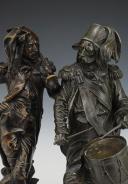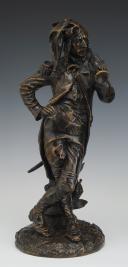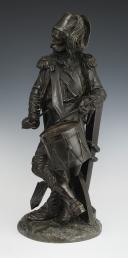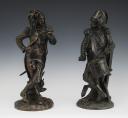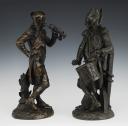
ARMAND LE VÉEL - Pair of bronzes: INFANTRY TRUMPET AND DRUM, Revolution. 31168
Sold out
ARMAND LE VÉEL - Pair of bronzes: INFANTRY TRUMPET AND DRUM, Revolution.
Trumpet: Bronze with a brown patina. Height 47 cm, base diameter 19 cm.
Drum: Bronze with a brown patina. Height 47 cm, base diameter 18.5 cm.
France.
Second half of the 19th century.
Perfect condition.
BIOGRAPHY:
Armand Jules Le Véel, born on January 27, 1821 in Bricquebec and died on July 26, 1905 in Cherbourg, was a French sculptor.
Born to merchants, Armand Le Véel was the eldest of a modest family of 13 children. He began his education at the Valognes college in 1830 to study humanities, and later at the Cherbourg college, where he showed an interest in drawing. In 1837, his parents sent him to Rouen as a grocery clerk and accountant, where he spent three years without finding a taste for commerce.
On December 14, 1840, he arrived in Paris to pursue his art, with no resources. He worked various jobs to make a living and manufactured products for the Susse House for the making of plaster statuettes that were in vogue at the time.
He met the sculptor Auguste Poitevin, a student of François Rude, who introduced him in 1845 to the master's workshop, from which he retained a late romantic inspiration. He worked alongside Emmanuel Frémiet and Jean-Baptiste Carpeaux. He created his first works, a series of six plaster statuettes of characters inspired by French history, including a Leaguer, a Huguenot, and a Representative of the People at Armies, known as Vox populi.
Enlisted on February 24, 1848 during the Revolution on the barricade of Rue de Rivoli in Paris, he was proclaimed commander, receiving Odilon Barrot before dismissing him, then entered among the first into the Tuileries Palace.
He resumed his creations in 1850, supported by an annual subsidy of 600 francs paid for three years by the Manche department council and doubled by the councilor of Canisy, Alexis Félix Sanson-Lavalesquerie. After this pension period, the departmental assembly commissioned him a marble bust of Admiral de Tourville.
In 1852, the Cherbourg municipal council decided to erect a Monument to Napoleon in the form of an equestrian statue. Le Véel made a proposal in early 1853, which was completed on April 25, 1855. In the meantime, he practiced equestrian statuary in a workshop on the Île des Cygnes provided by the Directorate of Fine Arts, creating two Charlemagnes and a Bonaparte in Italy.
A friend of Jules Barbey d'Aurevilly, he married Eugénie Feuchère in 1855, the daughter of the sculptor Jean-Jacques Feuchère.
On July 21, 1858, the Monument to Napoleon arrived by train on the occasion of the visit of Napoleon III and Empress Eugénie, whom Le Véel had met in 1852 when she was still Miss Montijo, and whom he was supposed to sculpt a bust. The imperial couple came for the inauguration of the Mantes-la-Jolie - Cherbourg railway line, the launch of the Ville de Nantes, and the immersion of a new basin in the military port. However, the inauguration of the statue was not desired by Napoleon III, who was engaging in diplomatic rapprochement with the United Kingdom. Therefore, it was postponed to the last day of the imperial visit, once the distinguished guest, Queen Victoria, had departed. What was supposed to be Le Véel's crowning achievement was quickly dispatched, and the sculptor was not awarded the Legion of Honor, contrary to his hopes and those of Mayor Joseph Ludé.
Le Véel attributed this lack of recognition to his past as a revolutionary in 1848. However, he was decorated in 1863. It is more likely that his challenging attitude towards the authorities, such as being absent when the emperor visited his workshop or refusing to alter his projects based on the remarks of the commissioners, did not favor his acceptance into official circles for public commissions. Nevertheless, he received several commissions for plaster, bronze, and stone statues, particularly in his department. Among other works, he created a stone statue of Tancred de Hauteville for the Coutances Cathedral and bronze statues of Joan of Arc, including the Monument to Joan of Arc at the former Orléans bishopric. This statue was melted down in 1941 under the Vichy regime; only the horse's rear and Joan of Arc's torso remain preserved at the Orléans City Hall. In 1870, he was one of eleven members of the commission, chaired by Gustave Courbet, tasked with saving works of art in Paris before the city was besieged by the Prussians, and he opposed the demolition of the Vendôme Column.
He retired in September 1882 in Cherbourg and stopped creating. After donating several works to the city, which took care of melting them down, he was appointed curator of the Thomas-Henry Museum and advocated for the collections to find shelter in a new dedicated building. On May 7, 1899, he attended the inauguration of the Monument to Joan of Arc in Orléans, donated to the bishopric by him.
Living on Rue du Maupas in Cherbourg, he died on July 26, 1905, leaving his collection of artworks and antiquities (tapestries, weapons, furniture, etc.) to the City of Cherbourg. It was exhibited for half a century in the west pavilion of the theater before being consolidated with his works at the Thomas-Henry Museum. Several of his works are also preserved in the Museum of Fine Arts in Bordeaux. He was buried in the Aiguillons Cemetery in Cherbourg.
Trumpet: Bronze with a brown patina. Height 47 cm, base diameter 19 cm.
Drum: Bronze with a brown patina. Height 47 cm, base diameter 18.5 cm.
France.
Second half of the 19th century.
Perfect condition.
BIOGRAPHY:
Armand Jules Le Véel, born on January 27, 1821 in Bricquebec and died on July 26, 1905 in Cherbourg, was a French sculptor.
Born to merchants, Armand Le Véel was the eldest of a modest family of 13 children. He began his education at the Valognes college in 1830 to study humanities, and later at the Cherbourg college, where he showed an interest in drawing. In 1837, his parents sent him to Rouen as a grocery clerk and accountant, where he spent three years without finding a taste for commerce.
On December 14, 1840, he arrived in Paris to pursue his art, with no resources. He worked various jobs to make a living and manufactured products for the Susse House for the making of plaster statuettes that were in vogue at the time.
He met the sculptor Auguste Poitevin, a student of François Rude, who introduced him in 1845 to the master's workshop, from which he retained a late romantic inspiration. He worked alongside Emmanuel Frémiet and Jean-Baptiste Carpeaux. He created his first works, a series of six plaster statuettes of characters inspired by French history, including a Leaguer, a Huguenot, and a Representative of the People at Armies, known as Vox populi.
Enlisted on February 24, 1848 during the Revolution on the barricade of Rue de Rivoli in Paris, he was proclaimed commander, receiving Odilon Barrot before dismissing him, then entered among the first into the Tuileries Palace.
He resumed his creations in 1850, supported by an annual subsidy of 600 francs paid for three years by the Manche department council and doubled by the councilor of Canisy, Alexis Félix Sanson-Lavalesquerie. After this pension period, the departmental assembly commissioned him a marble bust of Admiral de Tourville.
In 1852, the Cherbourg municipal council decided to erect a Monument to Napoleon in the form of an equestrian statue. Le Véel made a proposal in early 1853, which was completed on April 25, 1855. In the meantime, he practiced equestrian statuary in a workshop on the Île des Cygnes provided by the Directorate of Fine Arts, creating two Charlemagnes and a Bonaparte in Italy.
A friend of Jules Barbey d'Aurevilly, he married Eugénie Feuchère in 1855, the daughter of the sculptor Jean-Jacques Feuchère.
On July 21, 1858, the Monument to Napoleon arrived by train on the occasion of the visit of Napoleon III and Empress Eugénie, whom Le Véel had met in 1852 when she was still Miss Montijo, and whom he was supposed to sculpt a bust. The imperial couple came for the inauguration of the Mantes-la-Jolie - Cherbourg railway line, the launch of the Ville de Nantes, and the immersion of a new basin in the military port. However, the inauguration of the statue was not desired by Napoleon III, who was engaging in diplomatic rapprochement with the United Kingdom. Therefore, it was postponed to the last day of the imperial visit, once the distinguished guest, Queen Victoria, had departed. What was supposed to be Le Véel's crowning achievement was quickly dispatched, and the sculptor was not awarded the Legion of Honor, contrary to his hopes and those of Mayor Joseph Ludé.
Le Véel attributed this lack of recognition to his past as a revolutionary in 1848. However, he was decorated in 1863. It is more likely that his challenging attitude towards the authorities, such as being absent when the emperor visited his workshop or refusing to alter his projects based on the remarks of the commissioners, did not favor his acceptance into official circles for public commissions. Nevertheless, he received several commissions for plaster, bronze, and stone statues, particularly in his department. Among other works, he created a stone statue of Tancred de Hauteville for the Coutances Cathedral and bronze statues of Joan of Arc, including the Monument to Joan of Arc at the former Orléans bishopric. This statue was melted down in 1941 under the Vichy regime; only the horse's rear and Joan of Arc's torso remain preserved at the Orléans City Hall. In 1870, he was one of eleven members of the commission, chaired by Gustave Courbet, tasked with saving works of art in Paris before the city was besieged by the Prussians, and he opposed the demolition of the Vendôme Column.
He retired in September 1882 in Cherbourg and stopped creating. After donating several works to the city, which took care of melting them down, he was appointed curator of the Thomas-Henry Museum and advocated for the collections to find shelter in a new dedicated building. On May 7, 1899, he attended the inauguration of the Monument to Joan of Arc in Orléans, donated to the bishopric by him.
Living on Rue du Maupas in Cherbourg, he died on July 26, 1905, leaving his collection of artworks and antiquities (tapestries, weapons, furniture, etc.) to the City of Cherbourg. It was exhibited for half a century in the west pavilion of the theater before being consolidated with his works at the Thomas-Henry Museum. Several of his works are also preserved in the Museum of Fine Arts in Bordeaux. He was buried in the Aiguillons Cemetery in Cherbourg.
Reference :
31168
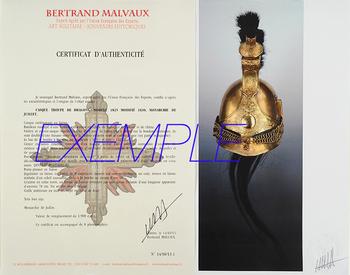
Next update Friday, december 12 at 13:30 PM
FOR ALL PURCHASES, PAYMENT IN MULTIPLE CHECKS POSSIBLE
bertrand.malvaux@wanadoo.fr 06 07 75 74 63
SHIPPING COSTS
Shipping costs are calculated only once per order for one or more items, all shipments are sent via registered mail, as this is the only way to have proof of dispatch and receipt.
For parcels whose value cannot be insured by the Post, shipments are entrusted to DHL or Fedex with real value insured, the service is of high quality but the cost is higher.
RETURN POLICY
Items can be returned within 8 days of receipt. They must be returned by registered mail at the sender's expense, in their original packaging, and in their original condition.
AUTHENTICITY
The selection of items offered on this site allows me to guarantee the authenticity of each piece described here, all items offered are guaranteed to be period and authentic, unless otherwise noted or restricted in the description.
An authenticity certificate of the item including the description published on the site, the period, the sale price, accompanied by one or more color photographs is automatically provided for any item priced over 130 euros. Below this price, each certificate is charged 5 euros.
Only items sold by me are subject to an authenticity certificate, I do not provide any expert reports for items sold by third parties (colleagues or collectors).
FOR ALL PURCHASES, PAYMENT IN MULTIPLE CHECKS POSSIBLE
bertrand.malvaux@wanadoo.fr 06 07 75 74 63
An authenticity certificate of the item including the description published on the site, the period, the sale price, accompanied by one or more color photographs is automatically provided for any item priced over 130 euros. Below this price, each certificate is charged 5 euros.
Only items sold by me are subject to an authenticity certificate, I do not provide any expert reports for items sold by third parties (colleagues or collectors).
